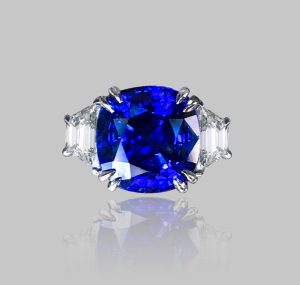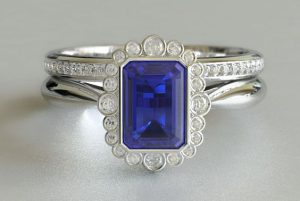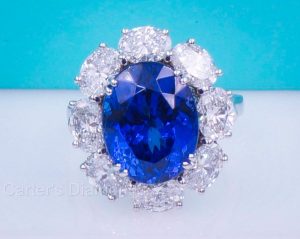 At Los Angeles Jewelry Buyer, we specialize in purchasing extraordinary sapphire jewelry ordinarily sold at auction houses like Christie’s and Sotheby’s. If you have been wondering how to sell a sapphire diamond ring, necklace, or earrings, our Los Angeles jewelry buyers can help.
At Los Angeles Jewelry Buyer, we specialize in purchasing extraordinary sapphire jewelry ordinarily sold at auction houses like Christie’s and Sotheby’s. If you have been wondering how to sell a sapphire diamond ring, necklace, or earrings, our Los Angeles jewelry buyers can help.
In this article, we cover some of the common questions our clients have had when selling sapphire jewelry for a generous cash offer in Los Angeles County.
1) What is a sapphire and what does “cornflower blue” look like?
Sapphires are precious gemstones in the corundum mineral family. Trace amounts of iron, titanium, chromium, copper, or magnesium can give the stone a blue, yellow, purple, orange, or a greenish color, while impurities can yield a pink or reddish tint.
Standard sapphires are blue in color, with “cornflower blue” being the most precious hue. Cornflower blue is a medium-dark to violet-blue hue which derives its name from a European flower known by various names, including cornflower, bachelor’s button, bluebottle, and boutonniere flower. Sapphires that are not blue but exhibit other colors are known as fancy sapphires.
2) Why is my cash offer so much less than my sapphire jewelry’s retail price?
When people sell sapphire jewelry, they are sometimes surprised when they don’t receive a cash offer closer to the retail price of their sapphire necklace, earrings, or ring. When selling sapphire jewelry in Los Angeles, it is important to remember that the retail price of your item was likely at least triple the manufacturing cost. This usually holds true even if you bought your sapphire jewelry online or at advertised “wholesale” prices.
Call Toll Free: (866) 734-8162
3) What aspects of my sapphire jewelry will increase the cash offer?
There a variety of factors that can impact the cash offer of sapphire earrings, pendants, and other sapphire jewelry. The important thing to keep in mind is that the value of your sapphire jewelry is based primarily on the origin, color, carat size, and quality of the sapphire.
The most important aspect is your sapphire’s color–the most sought after being the “cornflower blue” we mentioned above. In many cases, the sapphire will be extracted and the rest of the jewelry melted down and sold at scrap prices. The exception to this rule is if you are selling sapphire diamond jewelry manufactured by a designer jewelry brand like Cartier, Van Cleef & Arpels, Tiffany & Co., or Chopard.
4) Will I get a cash offer close to the appraisal value of my sapphire jewelry?
In most cases, the answer is no. If your sapphire jewelry came with a “replacement” appraisal or was appraised for insurance purposes, the appraisal value is the retail value of your sapphire jewelry. And, as we mentioned previously, the retail value of an sapphire pendant, ring, or necklace is usually 3 times more than the manufacturing cost.
However, if you take your sapphire jewelry to a Los Angeles jewelry appraiser and ask for a re-sell price estimate, you usually will be able to receive a cash offer that is closer to that price, depending on the accuracy of the sapphire appraisal.
5) Can I sell my sapphire jewelry for a good price even if it is not accompanied by a lab report?
You can sell large carat sapphire jewelry to Los Angeles Jewelry Buyer, regardless of whether or not your ring is accompanied by a lab report. However, if you do have a lab report for your sapphire jewelry from a respected gems lab (such as GIA) do let us know because this will help us to evaluate the sapphire’s correct value.
6) What about trying to sell my sapphire jewelry on eBay?
While some people have success selling sapphire diamond jewelry on eBay, many more are not so fortunate. The reason so many people find it hard to sell sapphire jewelry on eBay is that the world market is full of synthetic sapphires and low quality sapphires. Potential buyers are therefore legitimately worried about buying fake or low quality sapphire jewelry online.
Sellers who are successful at selling a sapphire necklace or ring on eBay are usually private individuals who have a long track record of successful sales and high ratings, or professional jewelers with a bricks and mortar store.
Arrange a Free Sapphire Jewelry Appraisal in Los Angeles
Contact our sapphire jewelry buyers today to arrange a free verbal appraisal of your sapphire ring, necklace, brooch, or earrings. You can also get the process started online by telling us about the sapphire jewelry you wish to sell in the contact form below.
Call Toll Free: (866) 734-8162
Los Angeles Jewelry Buyer specializes in evaluating the market worth of antique sapphire rings and high-brand sapphire and diamond jewelry, including sapphire jewelry from Cartier, Harry Winston, Van Cleef & Arpels, Boucheron, Rainbow Sapphire Collection, Tiffany & Co., & other fine jewelry houses.
Learn All About Sapphires
 Sapphire is the name given to the non-red, gem quality variety of the mineral corundum—the second hardest substance on earth, just below the diamond. Corundum itself is not a particularly rare mineral, with most being translucent to opaque and heavily included, and useful mainly as an abrasive for industrial purposes. Gem quality corundum, on the other hand, is extremely rare.
Sapphire is the name given to the non-red, gem quality variety of the mineral corundum—the second hardest substance on earth, just below the diamond. Corundum itself is not a particularly rare mineral, with most being translucent to opaque and heavily included, and useful mainly as an abrasive for industrial purposes. Gem quality corundum, on the other hand, is extremely rare.
Blue is the classic and traditional color of sapphire—the name sapphire itself comes from the Greek word for blue. Corundum that has trace amounts of iron results in a blue sapphire, and chromium impurities result in a pink or red color, with red corundum well-known as its own colored gemstone, the ruby. In addition to the blue sapphire and the ruby, the corundum family of colored gemstones includes so-called “fancy sapphires:” corundum with trace amounts of titanium, copper, or magnesium can result in yellow, orange, or green sapphires respectively.
Sapphires are found in only a few locations in the world, including the most famous blue sapphire deposits in Kashmir, Burma, and Sri Lanka. Recent deposits found in Madagascar, Tanzania, and Australia are considered today’s most important deposits.
Learn About Blue Sapphires
 Sapphires are evaluated based on their color, clarity, size, and cut, but the most important factor is generally their color. Color is broken down into three components: hue, saturation, and tone, with “hue” being commonly understood as “color.” Blue sapphires exhibit various mixtures of primary hue (blue), and secondary hues (most commonly purple, violet, and green), as well as various tonal levels (shades) and levels of saturation (vividness).
Sapphires are evaluated based on their color, clarity, size, and cut, but the most important factor is generally their color. Color is broken down into three components: hue, saturation, and tone, with “hue” being commonly understood as “color.” Blue sapphires exhibit various mixtures of primary hue (blue), and secondary hues (most commonly purple, violet, and green), as well as various tonal levels (shades) and levels of saturation (vividness).
Judged mainly on the purity of their primary hue, blue sapphires with up to fifteen percent violet and purple secondary hues are generally regarded as fine quality, but any amount of green as a secondary hue is considered a detriment to the stone’s overall quality. Gray is a common saturation modifier, but it generally reduces the saturation or brightness of the hue and compromises the impact of the colored gemstone.
Learn About Fancy Colored Sapphires
 The presence of other minerals in corundum leads to sapphires of nearly every color in the rainbow. While blue sapphires get their color from iron and titanium, violet stones owe their color to the presence of vanadium, and pink sapphires are tinted by chromium. Yellow and green sapphires are fairly common, though most yellow sapphires are naturally more lightly colored. Combinations of iron and vanadium can lead to orange stones.
The presence of other minerals in corundum leads to sapphires of nearly every color in the rainbow. While blue sapphires get their color from iron and titanium, violet stones owe their color to the presence of vanadium, and pink sapphires are tinted by chromium. Yellow and green sapphires are fairly common, though most yellow sapphires are naturally more lightly colored. Combinations of iron and vanadium can lead to orange stones.
One particular pinkish-orange sapphire is known as “padparadscha,” from the Sinhalese word for the “lotus blossom,” which has a pinkish salmon color. Originally found in Sri Lanka, padparadscha sapphires have also been found in Vietnam and parts of East Africa, though they remain quite rare. Treasured by connoisseurs, padparadscha sapphires are extremely valuable, even though there is no uniform standard for the color.
Learn About Star Sapphires & Color Changing Sapphires
 Star sapphires exhibit a phenomenon known as asterism. Tiny needle-like rutile inclusions intersect in the crystal structure and align to cause a star shaped pattern in the top of the sapphire. These colored gemstones are typically cut en cabochon, with the center of the star near the top of the dome.
Star sapphires exhibit a phenomenon known as asterism. Tiny needle-like rutile inclusions intersect in the crystal structure and align to cause a star shaped pattern in the top of the sapphire. These colored gemstones are typically cut en cabochon, with the center of the star near the top of the dome.
When viewed with a single overhead light source, a six rayed ‘star’ shaped pattern appears. Asterism can appear in any colored sapphire, and is typically valued by its strength and contrast with the color of the stone. Occasionally, twelve rayed stars can be found, due to two sets of inclusions.
Some rare sapphires, called color-change sapphires, manifest different colors in different kinds of light. Some color-change sapphires appear blue in outdoor light and purple under incandescent, indoor light, and some appear greenish in daylight and reddish-violet in incandescent light. The color-change phenomenon is due to the interaction of the different light’s wavelength and metal impurities in the sapphire itself. The actual color change can be judged as weak, moderate, or strong, and the strength of the stone’s color change is the most important factor affecting the value of the colored gemstone.
Sapphire History and Lore
 Archaeological evidence reveals that the very earliest sapphires most likely came from Sri Lanka, traveling through the Middle East to the Mediterranean cultures and eventually to Europe during the Roman Empire. The earliest sapphires were simply polished rounded stones, sometimes drilled and used as beads for necklaces and bracelets, or set en cabochon. Surface faceting of sapphires does not appear until after the 16th century.
Archaeological evidence reveals that the very earliest sapphires most likely came from Sri Lanka, traveling through the Middle East to the Mediterranean cultures and eventually to Europe during the Roman Empire. The earliest sapphires were simply polished rounded stones, sometimes drilled and used as beads for necklaces and bracelets, or set en cabochon. Surface faceting of sapphires does not appear until after the 16th century.
Traditionally, the sapphire has symbolized truth, sincerity, nobility, and faithfulness. The kings and queens of ancient Greece and Rome believed sapphires could protect them from envy, and many believed wearing sapphires was an antidote against poison and would shield them from disease. Sapphires have been worn by the clergy since the Middle Ages, the blue of the stone thought to emulate the pure blue sky of heaven.
Magical properties have also been ascribed to the sapphire. Once used to banish evil spirits and negative spells, sapphires were also thought to guard against poisonous creatures, and some believed that they could increase communication with angels and spirit guides. One curious belief about color-changing sapphires was that they had the power to detect female virtue, though the “‘test” was often manipulated. If the owner of the stone wished to prove a woman’s virtue, he would have her wear it in only daylight, but if he wished to prove the opposite, he would time the test so that it began in daylight and ended under candle or lamp light. The stone would change color, supposedly indicating her lack of virtue.
Sapphire Gemstone Treatments
 Sapphires today are often heat treated to improve their color, clarity, and overall appearance. Although this treatment has been known since antiquity, it was perfected in the last half of the twentieth century, and most sapphires available today are heat treated. The colored gemstones are heated to temperatures between 500 and 1800 degrees celsius for several hours, enhancing their clarity by reducing or eliminating needle-like rutile inclusions. Heat treatment is considered stable and permanent, and is accepted in the industry when disclosed. Untreated sapphires of exceptional clarity and color are rare indeed, and command the highest prices.
Sapphires today are often heat treated to improve their color, clarity, and overall appearance. Although this treatment has been known since antiquity, it was perfected in the last half of the twentieth century, and most sapphires available today are heat treated. The colored gemstones are heated to temperatures between 500 and 1800 degrees celsius for several hours, enhancing their clarity by reducing or eliminating needle-like rutile inclusions. Heat treatment is considered stable and permanent, and is accepted in the industry when disclosed. Untreated sapphires of exceptional clarity and color are rare indeed, and command the highest prices.
Other treatments include lattice diffusion treatments and fracture filling. Lattice diffusion is a process in which chemicals and heat are used to diffuse an element, like beryllium, into the sapphire to change its color at the molecular level. Fracture filling is a treatment that uses resin or other fillers to improve transparency and clarity, but it is neither stable nor permanent. Both of these treatments are not widely accepted in the industry and should always be disclosed as they greatly affect the value of the sapphire.
How to Sell Sapphire Jewelry in Los Angeles, CA
If you own expensive sapphire jewelry that you would like to sell immediately for a generous cash offer, please contact Los Angeles Jewelry Buyer today. We are widely recognized as the best place to sell sapphire rings, earrings, and necklaces of exceptional quality, including collectible sapphire jewelry from Tiffany & Co., Harry Winston, Cartier, Van Cleef & Arpels, Chopard, and other luxury brands.
Call Toll Free: (866) 734-8162
Start SellingWe purchase fine sapphires from all origins, including Kashmir sapphires, Burmese sapphires, and Sri Lankan sapphire. We also purchase fine sapphire rings and jewelry set with color changing sapphires, rare star sapphires, and cat’s eye sapphires.
Do you have emerald jewelry that you wish to sell? Visit our page on: How to Sell Emerald Jewelry in Los Angeles, CA.